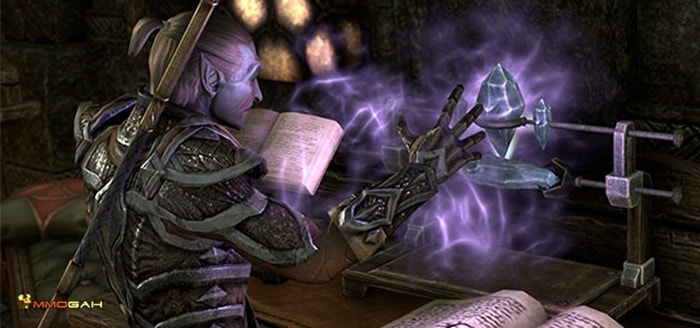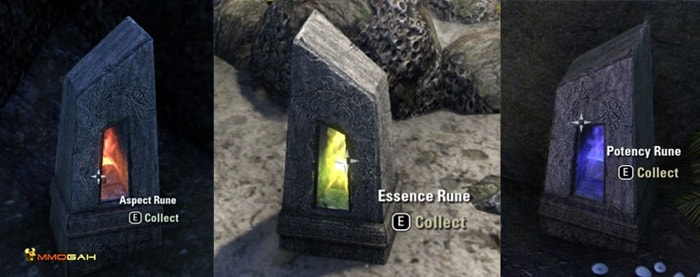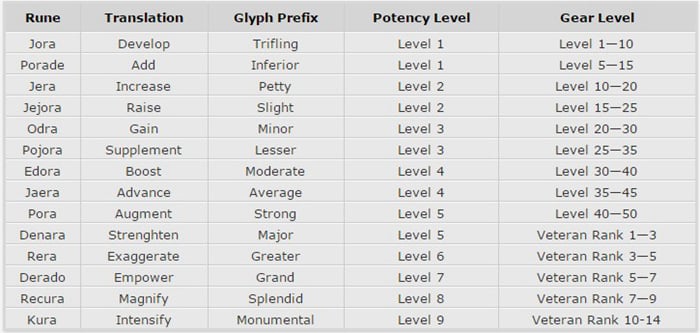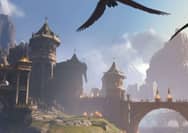Enchanting provides Glyphs in Elder Scrolls Online. Glyphs are enchantments which are applied on gear. There’s three types of glyphs: armor glyphs, weapon glyphs, and jewelry glyphs. Glyphs are crafted at enchanting station, typically found in towns. The combination of runes used to craft the glyph affects the quality and effects of the final glyph, much like the combination of reagents does in Alchemy.
Unlike provisioning and alchemy, enchanting grants you permanent bonuses on your armor, jewelry and weapons. You do have to charge your weapons with soul gems as the effect depletes in combat. Enchanting can give you a boost in most of your stats with some exceptions like crit percentage or crit damage. However, it’s not just adding bonuses. There’s also some special effects like granting a damage shield, dealing unresistable damage, reduction costs, potion boost and more.

Leveling Enchanting
Leveling up Enchanting is an arduous process. It has been made easier with incremental patches, but it is still the slowest ranking of the professions.
Deconstruction always grants more inspiration than creation and yields materials. Items made by another player gives the most inspiration, enhanced with higher level and better item quality.
1. Find a crafting partner who is near your crafting level.
2. Each partner creates glyphs for the maximum level as possible in the following progression: 4, 16, 26, 36, 46, Champion: 10, 40, 80, 100
3. Trade the items to each other.
4. Deconstruct the glyphs made by the other person.
Enchanting Skills and Maxing Out
To max out your ESO enchanting level, you will need to spend skill point in the following two Enchanting skill trees: Aspect Improvement and Potency Improvement.
All of the other enchanting skills are not required to max your enchanting level, but they will help. Keen Eye: Runes Stones will make it easier for you to spot rune stones out in the world to you can get your mats together more quickly; Hireling will have a minion mail you rune stones every day; and Aspect Extraction increases your chances of extracting an aspect.
Profitibility
The profitibility of Enchanting should be good, as there are many people who are not interested in the trade skills but are more interested in questing and dungeons, and they will want to maximize their potency.

Runes
The runes are not difficult to find. They are usually found standing near stones or trees. But you must be quick once you detect one as other players are also searching for them.
Rune Types
The three different types of runes that must be combined to form a glyph are: an Essence Rune, a Potency Rune, and an Aspect Rune. You can tell the type of a rune by its shape, and the shape of the rune determines which slot it goes in when you are creating glyphs.
Essence Runes: Triangle
Potency Runes: Square
Aspect Runes: Circle
Rune Functions
Each of the three types of runes serve a different but important purpose when you are crafting your glyph.
Essence Runes: Determine the type of enchantment the glyph will have (frost, fire, etc.).
Potency Runes: Determine whether the glyph will increase or decrease effects (eg: more outgoing damage and less incoming damage).
Aspect Runes: Determine the glyph's quality.
Essence Runes
The essence rune is probably the most important part of the Glyph because it decides the enchantment effect. All essence runes can be found in any zone, they aren’t restricted to a location. There are 17 different essence runes, each having a negative and a positive effect depending on the potency rune. There are actually 19 but the Lire and Jaedi essence runes don’t have a specific effect because people report different outcomes when using these two essence runes. There are three armor effects, 14 weapon effects and 17 jewelry effects.
Available Essence Runes
Dekeipa: Frost
Deni: Stamina
Denima: Stamina Regeneration
Deteri: Armor
Haoko: Disease
Kaderi: Shield
Kuoko: Poison
Makderi: Spell Damage
Makko: Magicka
Makkoma: Magicka Regeneration
Meip: Shock
Oko: Health
Okoma: Health Regeneration
Okori: Power
Oru: Alchemist
Rakeipa: Fire
Taderi: Physical Damage
Potency Runes
Potency Runes are one of the three required runestones for Glyphs. Potency runes determine how high level you must be to be able to use the Glyph. They are gathered from blue rune nodes, and are square-shaped.
Potency Runes can be either additive or subtractive. As an example, you can combine any of the additive potency runes together with the Essence rune ‘Rakeipa’ (translation is Fire) to create a weapon enchant glyph which deals x Fire damage. If you use a subtractive rune instead of an additive rune, you get a different glyph. In this case it would be a Fire Resistance jewelry enchant glyph.

Aspect Runes
Aspect Runes can be gathered from red runestone nodes and can be recognized in the inventory by their round shape.
This type of runes determines the quality of the glyph you will make. As you probably know there are 5 quality levels starting from Basic up to Legendary. You can influence the quality of your future Glyph by changing the Aspect Rune.
Available Aspect Runes
Ta: Base / Level 1
Jejota: Fine / Level 2
Denata: Superior / Level 3
Rekuta: Artifact / Level 4
Kuta: Lgendary / Level 5
Tips
Stick with it. Even though it is a really slow leveling process, the glyphs that you make are level locked, meaning you can only use them when you reach a certain level. For example, the first potency rune, Jora, is used for glyphs levels 1-10. Porade, the second potency rune, is level 5-15. You cannot use a glyph created with the Porade rune unless you are at least level 5. So, even if your enchanting level is low, your character level can be higher.
The Potency Improvement passives, which are the required passives to create better runes, are set at low levels. For example, you only need to have level 10 enchanting to make runes for the levels up to 35! It’s fine if your enchanting level is only 1/3 of your character level, because that’s all you need. Also, after Potency Improvement rank III, there is no level requirement for rank IV other than having rank III, and so on (so at enchanting level 10, you can create the best glyphs in the game)! You’re at enchanting level 8, so you can make glyphs for characters up to level 25!
If you need runestones, you can either buy them fairly cheap from merchants, or you can spend a little extra to get a couple of glyphs, the deconstruct those glyphs
If you have extra runes and you buy the type that you are missing (like aspect runes), you can use runes you already have to make glyphs, and sell those glyphs to the merchant to purchase more runes!
If you buy glyphs, after you deconstruct them you can always re-make them and sell them back, using that gold (plus some extra) to buy more glyphs.
ESO is more and more interesting along with the update 12 which brings players together in One Tamriel now. Just like other MMOs, if you don’t have enough time to improve your level, you can use ESO Gold to purchase not only gear and weapons, but also awesome items in game. Of course, you can buy ESO Gold right here in Mmogah, since it’s a so reliable ESO Gold seller that more and more players chose to buy ESO Gold from. If you don’t know how to choose a Safe website to buy ESO gold, you can read this Guide first, you've found which one is the best of those choices! Whenever you need to buy ESO Gold, our Live Chat is 24/7 online.
Helpful Links:
ESO's Housing System Coming Soon



